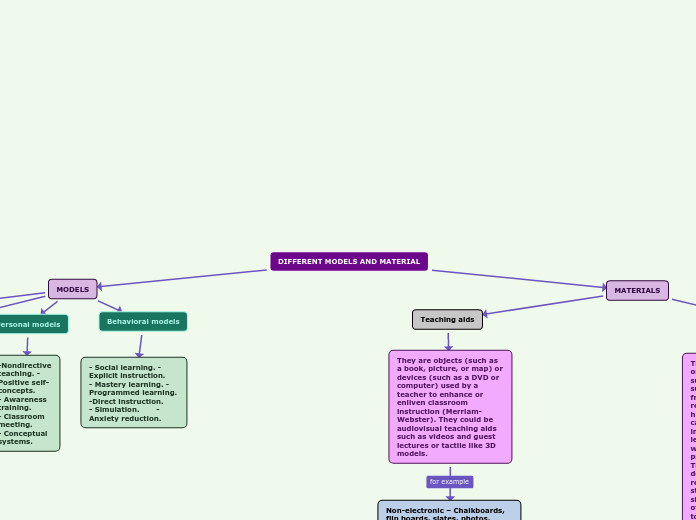CONCLUSIONS: From my point of view; The models and materials are relevant to the planning of classes, since it is essential that when writing the objectives that are desired to be achieved in the student; because they facilitate the teaching-learning process; In addition, they help improve the effectiveness of learning.
Much research has been done on the various teaching models; each one has good elements; depending on the way in which they are put into practice. From my point of view, all models have great contributions to carry out teaching practice. Likewise, there are various materials that can help us carry out educational practice; some of these have already been created by researchers who have observed teaching practice, but from my point of view, the teacher constantly creates his own teaching resources for the development of the skills of his students; using homemade materials and even; "trash".
REFERENCES: -Aditya Shukla, April 28, 2020 May 12, 2018. Teaching aids and Instructional materials- tools for teachers and students
https://cognitiontoday.com/2018/05/teaching-aids-and-instructional-materials-tools-for-teachers-and-students/ -Teaching Learning Material & Categories of TLM 137,068 vistas, 20 dic. 2017 NIOSSeniorSecondaryCourses https://www.youtube.com/watch?v=7o2mDFzv_d8 - file:///C:/Users/krism/OneDrive/Documentos/ciclo%20escolar%202019-2020/LIC.%20EN%20DOCENCIA%20DEL%20INGL%C3%89S/Techniques%20of%20teaching%20and%20learning%20of%20a%20language/MODULE%202/homework%204/0133749304.en.es.pdf
DIFFERENT MODELS AND MATERIAL
MATERIALS
Instructional materials
They are defined as resources that organize and support instruction, such as textbooks, tasks, and supplementary resources (adapted from Remillard & Heck, 2014). It refers to the human and non-human materials and facilities that can be used to ease, encourage, improve and promote teaching and learning activities. They are whatever materials used in the process of instruction (IGI global). The great Soviet encyclopedia defines IMs as educational resources used to improve students’ knowledge, abilities, and skills, to monitor their assimilation of information, and to contribute to their overall development and upbringing.
Traditional resources: lectures, talks, writings, project rubrics, guidelines, textbook primers, reference books, extra-readings, teacher and student-created summaries, workbooks, supplementary material such as flashcards and charts
Digital media: Videos, photos, presentations
Open resources: Expert blogs, open-source journals, public databases, open courseware, forums
Testing resources: Standardized tests, classroom assignments, online submissions, quizzes, essays, collaborative projects.
Teaching aids
They are objects (such as a book, picture, or map) or devices (such as a DVD or computer) used by a teacher to enhance or enliven classroom instruction (Merriam-Webster). They could be audiovisual teaching aids such as videos and guest lectures or tactile like 3D models.
Non-electronic – Chalkboards, flip boards, slates, photos, telescopes,
Electronic – Powerpoint slideshows, videos, Augmented reality/Virtual reality goggles, AV-room equipment
Classification 2:
Auditory: radios, tape recorders, CD players
Visual: Slides, projectors, digital screens
Audiovisual– Youtube content, Vines (yes, they are helpful), Ted Talks, Live streams, documentaries
Audiovisual and tactile – 3D models, plants, rocks, field visits...
MODELS
Behavioral models
- Social learning. -Explicit instruction. - Mastery learning. -Programmed learning. -Direct instruction. - Simulation. -Anxiety reduction.
Personal models
-Nondirective teaching. -Positive self-concepts. - Awareness training. - Classroom meeting. - Conceptual systems.
Social models
-Partners in learning. -Structured social inquiry. -Group investigation -Social inquiry. -Laboratory method. -Role playing. -Jurisprudential inquiry.
Information- Processing models
-Inductive thinking. -Scientific inquiry. -Picture word inductive. - Concept attainment. - Synectics. - Mnemonics. - Advanced organizers. - Inquiry training. -Cognitive growth.

